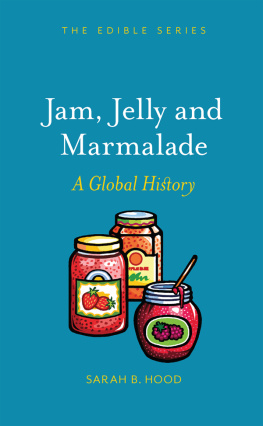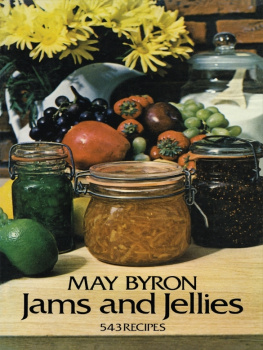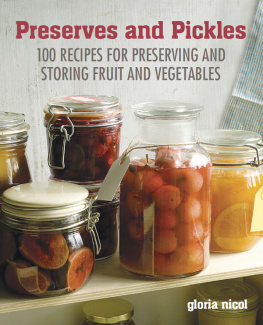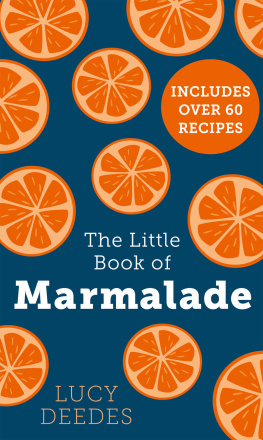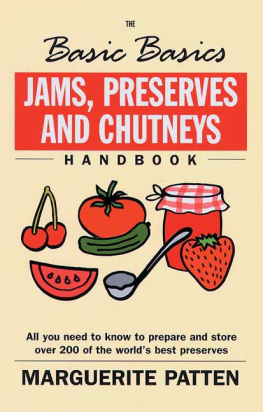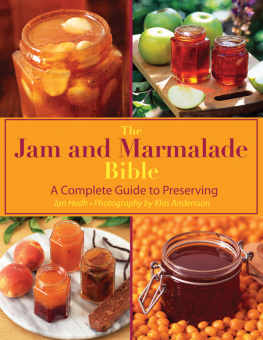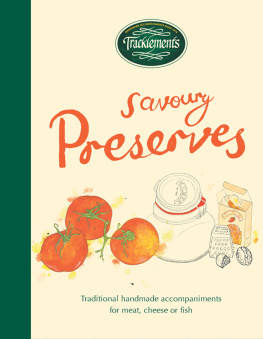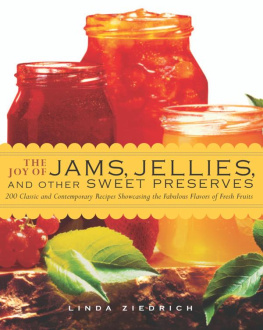JAM, JELLY
AND MARMALADE

Edible
Series Editor: Andrew F. Smith
EDIBLE is a revolutionary series of books dedicated to food and drink that explores the rich history of cuisine. Each book reveals the global history and culture of one type of food or beverage.
Already published
Apple Erika Janik, Avocado Jeff Miller, Banana Lorna Piatti-Farnell, Barbecue Jonathan Deutsch and Megan J. Elias, Beans Nathalie Rachel Morris, Beef Lorna Piatti-Farnell, Beer Gavin D. Smith, Berries Heather Arndt Anderson, Biscuits and Cookies Anastasia Edwards, Brandy Becky Sue Epstein, Bread William Rubel, Cabbage Meg Muckenhoupt, Cake Nicola Humble, Caviar Nichola Fletcher, Champagne Becky Sue Epstein, Cheese Andrew Dalby, Chillies Heather Arndt Anderson, Chocolate Sarah Moss and Alexander Badenoch, Cocktails Joseph M. Carlin, Coffee Jonathan Morris, Corn Michael Owen Jones, Curry Colleen Taylor Sen, Dates Nawal Nasrallah, Doughnut Heather Delancey Hunwick, Dumplings Barbara Gallani, Edible Flowers Constance L. Kirker and Mary Newman, Eggs Diane Toops, Fats Michelle Phillipov, Figs David C. Sutton, Foie Gras Norman Kolpas, Game Paula Young Lee, Gin Lesley Jacobs Solmonson, Hamburger Andrew F. Smith, Herbs Gary Allen, Herring Kathy Hunt, Honey Lucy M. Long, Hot Dog Bruce Kraig, Ice Cream Laura B. Weiss, Jam, Jelly and Marmalade Sarah B. Hood, Lamb Brian Yarvin, Lemon Toby Sonneman, Lobster Elisabeth Townsend, Melon Sylvia Lovegren, Milk Hannah Velten, Moonshine Kevin R. Kosar, Mushroom Cynthia D. Bertelsen, Mustard Demet Gzey, Nuts Ken Albala, Offal Nina Edwards, Olive Fabrizia Lanza, Onions and Garlic Martha Jay, Oranges Clarissa Hyman, Oyster Carolyn Tillie, Pancake Ken Albala, Pasta and Noodles Kantha Shelke, Pickles Jan Davison, Pie Janet Clarkson, Pineapple Kaori OConnor, Pizza Carol Helstosky, Pomegranate Damien Stone, Pork Katharine M. Rogers, Potato Andrew F. Smith, Pudding Jeri Quinzio, Rice Renee Marton, Rum Richard Foss, Saffron Ramin Ganeshram, Salad Judith Weinraub, Salmon Nicolaas Mink, Sandwich Bee Wilson, Sauces Maryann Tebben, Sausage Gary Allen, Seaweed Kaori OConnor, Shrimp Yvette Florio Lane, Soup Janet Clarkson, Spices Fred Czarra, Sugar Andrew F. Smith, Sweets and Candy Laura Mason, Tea Helen Saberi, Tequila Ian Williams, Tomato Clarissa Hyman, Truffle Zachary Nowak, Vanilla Rosa Abreu-Runkel, Vodka Patricia Herlihy, Water Ian Miller, Whiskey Kevin R. Kosar, Wine Marc Millon, Yoghurt June Hersh
Jam, Jelly
and Marmalade
A Global History
Sarah B. Hood
REAKTION BOOKS
To my sister Alexandra and my brother John, and their children Tara and Alex, with love and thanks for putting up with me for all these years.
Published by Reaktion Books Ltd
Unit 32, Waterside
4448 Wharf Road
London N1 7UX, UK
www.reaktionbooks.co.uk
First published 2021
Copyright Sarah B. Hood 2021
All rights reserved
No part of this publication may be reproduced, stored in a retrieval system, or transmitted, in any form or by any means, electronic, mechanical, photocopying, recording or otherwise, without the prior permission of the publishers
Page references in the Photo Acknowledgements and
Index match the printed edition of this book.
Printed and bound in India by Replika Press Pvt. Ltd
A catalogue record for this book is available from the British Library
eISBN 9781789143904
Contents

1
Preserving Traditions

When you open a jar of jam, jelly or marmalade, whats inside? First, the aroma: an intense waft of fresh raspberries, oranges or plums. Then, translucency and colour: brilliant gold, bright scarlet or deep indigo. Next, a pleasing gel, perhaps mixed with luscious fruit pieces. Finally, the sweet and tangy flavour melting on your tongue.
What else? A 2010 academic survey of Americans who make their own preserves showed how strongly people value the potent associations sealed along with the fruit. The survey respondents talked about how putting up, or canning, preserves made them feel a connection to older family members, to their forebears and to past cultures. Preserves also have a comforting quality: in their earliest incarnations, they were generally valued for their medicinal properties, and they continued routinely to be fed to invalids well into the nineteenth century.
Every jar of fruit preserves also contains a small miracle: a batch of fruit that ought to have mouldered away months ago, still as delectable as when it was harvested. Chemically speaking, the process is so complex that it seems surprising that anyone managed to figure it out. Nonetheless, human ingenuity, combined with lifetimes of observation, and trial and error, unlocked the secret many centuries ago. Essentially, enabling fruit to gel requires three elements in a fairly specific balance: pectin, sugar and acid.
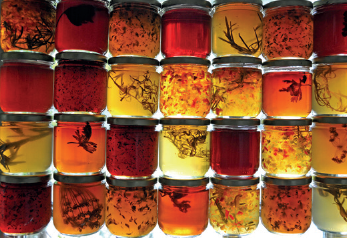
Jelly jars on display at Tangled Garden in Grand-Pr, Nova Scotia, Canada.
Pectin is a water-soluble polysaccharide (a carbohydrate) that occurs naturally in plants. When heated in liquid containing sugar, it forms polymer chains that support the structure of the mass it is contained in; in other words, it gels. Citrus fruits, quinces, apples, gooseberries and plums contain a lot. In raspberries, it occurs in the seeds. Pears, blueberries, bananas and many other fruits are weak in pectin; to these, extra pectin can be added.
Powdered or liquid commercial pectin is usually derived from apples or oranges. Some older recipes call for the addition of juice from apples or another pectin-rich fruit to improve the set of a preserve made with low-pectin ingredients. To reduce the amount of sugar needed to make jam, modern manufacturers have developed something called low-methoxyl pectin, which uses added calcium to form bridges that link the pectins together.
The classic ratio of sugar to fruit in jams and jellies is 1:1, including the sugar already present in the fruit. To modern, sugar-averse consumers, this seems like a lot, but commercial producers have frequently used much more, as sugar has often been cheaper than fruit. Also, besides imparting a bright, jewel-like colour and a firm gel, sugar plays an important role in preserving the fruit, retarding the growth of moulds and fungi after the jar is opened. Beet sugar acts in the same way as cane sugar. Honey has good preservative qualities, but does not offer the same look and texture. Corn syrup can be used, but only in combination with sugar.
In order to gel, jams, jellies and marmalades must have a low pH value, around 3.0, which signifies a fairly high level of acid (lower pH equals higher acid level). As it happens, the classic jam fruits, like apples, citrus fruits, quince, grapes and many berries, fall close to this level. Lemon and lime juice, which can be as low as 2.0, are often used to correct the acid level of preserves. A low-pH (or high-acid) environment is inhospitable to foodborne pathogens; in fact,

